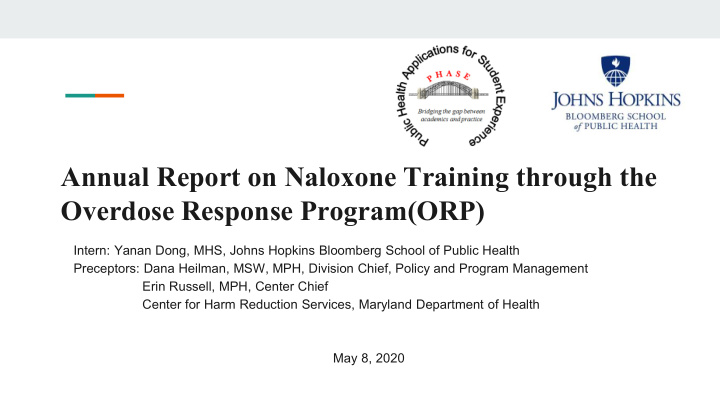



Annual Report on Naloxone Training through the Overdose Response Program(ORP) Intern: Yanan Dong, MHS, Johns Hopkins Bloomberg School of Public Health Preceptors: Dana Heilman, MSW, MPH, Division Chief, Policy and Program Management Erin Russell, MPH, Center Chief Center for Harm Reduction Services, Maryland Department of Health May 8, 2020
1. Project Introduction & Overview 2. Project Aims Contents 3. Methods 4. Findings 5. Limitations & Challenges 6. Moving Forward 7. Acknowledgements
Project Introduction & Overview Report Naloxone Administration Center for Harm Reduction Overdose Response Program(ORP) Services , MDH Started 2014 - education &naloxone training, dispensing Provide overdose Program Structure 1 : - Maryland Poison Control Private/Public Local health departments, Entities Community-based organizations(CBOs), Substance use disorder Treatment programs and Report Naloxone other health care providers Administration Individuals 1. Access Harm Reduction Program. https://phpa.health.maryland.gov/Pages/accessharmreduction.aspx accessed on Accessed on April 15, 2020
Project Aims Learn about what harm reduction strategies are currently employed by MDH to ● address the opioid epidemic in Maryland. Understand the history, transition and current structure of major programs such as Overdose Response Program(ORP). To resolve the data discrepancy between the MDH reporting guidance and ● authorized entities. Data cleaning, management and conduct descriptive analysis Draft the annual report for FY 2019 to present data from the ORP. ● Communicating the results of data analysis above to various audiences, including ● the public, government agencies, leadership within the Department, Center team members, and authorized ORP entities.
Methods Dataset introduction & management strategy Aggregated ● Training-related information (date, setting and training location by jurisdiction) ● Self-reported demographic information of individuals received training and ● naloxone kits/refills Report-related information (date of reporting and data entry contact information) ● Corrected records Descriptive Analysis: MDH ORP entities Distribution of demographic information - - Summarize key statistics Flagged records with reporting errors
Findings Figure 1A : Self-reported Age Figure 1B : Self-reported Race/ethnicity Figure 1C : Self-reported Gender Figure 1D : Self-reported Reason
Findings Figure 2. Top5 training setting Figure 3. Proportion of High-risk Group trained by setting
Findings Figure 4. FY2018-FY2019 Comparison per month Figure 5. 6-month Aggregated Data for comparison after the centralized purchasing model
Limitations & Challenges Limited Data Verification process due to the unprecedented COVID-19 - Aggregated Data, may not be sufficient to draw conclusion at the - individual-level Changes in the program structure may not introduce timely difference - in data available now Persistent under-reporting among authorized entities -
Moving Forward Combine the death statistics, naloxone administration reports, and GIS information with the training dataset In-depth Analysis Plans: to understand whether we have provided enough naloxone to the communities to achieve “saturation” and where the gaps/barriers are
Acknowledgements Huge thanks to: My preceptor Ms. Dana Heilman and Ms. Erin Russell Ms. Elizabeth Murphy, Mr. Mark Lockwood, and all team members in the Center for Harm Reduction Services. PHASE Program Team: Paulani Mui, Beth Resnick, April Tong and Eril Smith
Thank you for listening! Contact: Yanan Dong(ydong29@jhmi.edu) Dana Heilman(dana.heilman1@maryland.gov)
Recommend
More recommend